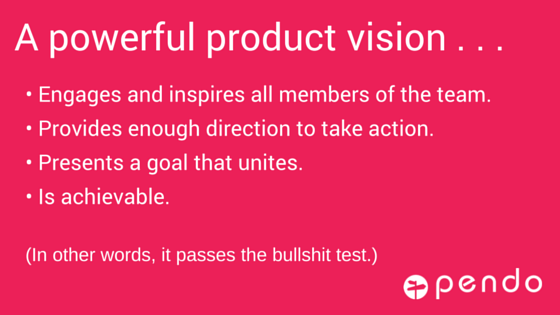Published Jun 1, 2016

They lack bite, resonance, and cohesiveness. It just feels like you’re going through the motions. But what makes a product vision powerful? To me, the format matters less than the content.
What makes a good product vision?
- It engages and inspires all members of the team. It presents a goal that unites the development team, the customers and users, and the business. Proposing a business goal without describing the human benefits doesn’t provide inspiration.
- It connects the who and the why through a narrative. It identifies the human beings involved and the outcomes you’d like to create for them. It is phrased in a way that identifies its impact on people, even if you’re talking about machines and code.
- It has a clear story arc that leads from now into the future. It describes the present state, the change needed, and the vision of a better state.
- It is written in language that the whole team understands and avoids marketing-speak or overly technical language. It should be easy to explain to new team members, even if they don’t know all of the details.
- It is presented in ways that engage various senses and ways of understanding — visual and auditory as well as verbal.
- It is detailed enough to feel precise and focused, but broad enough to leave room for creativity and individuality. Team members have leeway to dream up solutions.
- It provides enough direction for team members to take action. It makes it easy for them to make decisions. It provides a true north. Team members don’t need to second-guess themselves or ask for permission.
- It is singular and dominant and matches the reality of the team’s activities. Other activities don’t take up 80% of the team’s time. Your vision comprises the 80%, and other tasks are the periphery.
- There is a clear goal that the team can strive for in the immediate future, even if the overall vision is open-ended. There are ways to know if you’re on track (leading indicators) and ways to know that your efforts made a difference (trailing indicators and outcomes).
- It is achievable, or at least allows for concrete incremental progress. It doesn’t feel purely aspirational or top-down.
- It is logically connected to a larger goal, if one exists. If the mission addresses a problem in order to allow progress on a different problem, that relationship is clear.
- Team members can take it seriously, knowing that they won’t see the company do things that clash with the vision. No one just gives it lip service. If you were to put it up on the wall, no one would think it was annoying. In other words, it passes the bullshit test.
This post was originally published on Medium by John Cutler. John does word scrambles in his head about product management and still finds time to write for Pendo, wrangle product, chat with customers, and school us on the latest technology trends all the cool kids are using. For more tips from the Pendo product team, subscribe to our blog.


